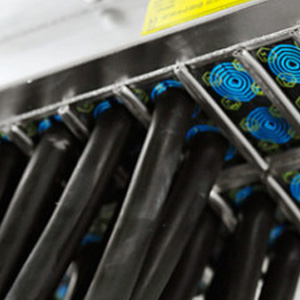 Heat shrink tubing has long been a vital component in electrical, automotive, telecommunications, and various other industries. As technology evolves, so does the design, functionality, and application of heat shrink products. Here’s a look at some of the innovative heat shrink technologies emerging today, as well as the future trends in this field.
Heat shrink tubing has long been a vital component in electrical, automotive, telecommunications, and various other industries. As technology evolves, so does the design, functionality, and application of heat shrink products. Here’s a look at some of the innovative heat shrink technologies emerging today, as well as the future trends in this field.
1. Advanced Materials for Specialized Applications
- Innovation: The development of new materials has significantly enhanced the performance and versatility of heat shrink tubing. Materials like fluoropolymers (such as PTFE and FEP), elastomers, and high-temperature-resistant plastics are being incorporated into heat shrink products to meet the needs of more demanding applications.
- Future Trend: Expect to see heat shrink tubing made from materials with even higher heat resistance, increased durability, and greater flexibility, ideal for extreme environments like aerospace, oil and gas, and deep-sea applications.
2. Heat Shrink Tubing with Built-In Adhesive Layers
- Innovation: Many heat shrink tubing products now feature an internal adhesive layer, which bonds securely to the underlying surface when heated. This technology allows for a tighter seal and provides additional protection against moisture, dust, and contaminants.
- Future Trend: We can anticipate more sophisticated adhesive formulations designed for specific uses, such as those resistant to oils, chemicals, or UV degradation. The future may also bring self-healing adhesives, improving the longevity and reliability of heat shrink applications.
3. Smart Heat Shrink Tubing (Sensors and Monitoring)
- Innovation: The integration of smart technologies into heat shrink tubing is a growing area. Heat shrink products embedded with sensors can monitor factors like temperature, pressure, or strain, providing real-time data to help detect potential issues or failures in electrical systems.
- Future Trend: As the Internet of Things (IoT) and Industry 4.0 gain traction, expect more “intelligent” heat shrink tubing to become widely available. These products will be able to collect and transmit data, alerting maintenance teams to potential failures before they occur. For example, sensors could alert users to overheating, corrosion, or even wear at a connection point, enabling predictive maintenance.
4. Multi-Layered Heat Shrink Tubing
- Innovation: Multi-layered heat shrink tubing is designed to offer enhanced protection by incorporating different materials within the same tubing. These can include layers for insulation, strain relief, flame retardancy, and moisture resistance, all combined into a single product.
- Future Trend: We’re likely to see more advanced multi-layered tubing with tailored layers that target specific challenges. Future heat shrink designs may include layers to protect against electromagnetic interference (EMI) and electrostatic discharge (ESD), which is critical for sensitive electronics.
5. Environmentally Friendly and Recyclable Heat Shrink
- Innovation: The demand for sustainable solutions has led to innovations in eco-friendly heat shrink materials. Manufacturers are exploring biodegradable and recyclable heat shrink options, often made from renewable resources.
- Future Trend: As environmental regulations tighten, the industry is expected to see a shift toward fully recyclable heat shrink tubing that does not compromise performance. Moreover, new manufacturing methods may reduce the carbon footprint of production, further contributing to sustainability efforts.
6. Custom-Printed Heat Shrink Tubing for Branding and Identification
- Innovation: Heat shrink tubing is increasingly being used for cable marking and branding. With advances in printing technologies, manufacturers can now create custom-printed heat shrink tubing that allows for logos, serial numbers, barcodes, or even QR codes to be printed directly onto the tubing.
- Future Trend: Expect even more customizable options in the future, allowing for more dynamic printing that changes based on the environment. This could include heat-sensitive printing that alerts users to overheating or other critical changes in a cable or device’s status.
7. Laser-Shrinkable Tubing
- Innovation: Traditional heat shrink tubing requires a heat source, such as a heat gun or oven, to shrink. However, recent developments have introduced laser-shrinkable tubing, which shrinks when exposed to specific wavelengths of laser light.
- Future Trend: As laser technology becomes more cost-effective and widely available, laser-shrinkable tubing could become a standard, particularly in environments where a precise and localized shrinking process is required. This could improve accuracy and speed in industrial applications.
8. Nano-Coated Heat Shrink Tubing for Enhanced Durability
- Innovation: The application of nanotechnology to heat shrink tubing is a promising frontier. Nano-coatings can significantly enhance the tubing’s durability, making it resistant to abrasion, chemicals, and other damaging environmental factors.
- Future Trend: As nano-coatings improve, expect to see heat shrink tubing that is virtually indestructible in harsh environments. This could be particularly beneficial for industries such as automotive, aerospace, and military, where the tubing needs to endure extreme wear and tear.
9. Thermally Conductive Heat Shrink Tubing
- Innovation: In electronic devices, managing heat dissipation is crucial. Thermally conductive heat shrink tubing is designed to help dissipate heat away from sensitive components, such as circuit boards or power connectors, thereby preventing overheating and extending the life of the devices.
- Future Trend: With the increasing miniaturization of electronic devices, thermally conductive heat shrink tubing will become even more important. Future designs could include advanced materials that help manage heat in more energy-efficient ways, potentially opening up new applications in high-performance electronics.
10. Heat Shrink Tubing for 5G and Telecommunications
- Innovation: As the telecommunications industry moves toward 5G networks, heat shrink tubing is being tailored to meet the specific needs of next-gen wireless technologies. This includes improving insulation for high-frequency signals and providing enhanced shielding from electromagnetic interference.
- Future Trend: Heat shrink tubing specifically designed for 5G infrastructure will become more prevalent, offering solutions that provide better performance, longevity, and protection for fiber optic cables and antennas used in 5G networks.
Conclusion:
Innovative heat shrink technologies are paving the way for more efficient, durable, and specialized solutions in various industries. As material science, IoT, and environmental considerations continue to evolve, heat shrink tubing will become an even more integral component in the design and protection of electrical systems. With advanced features such as smart monitoring, multi-layer protection, and environmentally friendly options, the future of heat shrink technology promises to address increasingly complex challenges while enhancing safety, reliability, and sustainability.


